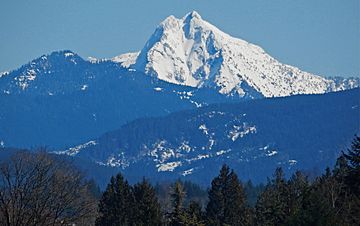Liberty Mountain (Washington) facts for kids
Quick facts for kids Liberty Mountain |
|
|---|---|

Liberty Mountain seen from Lake Stevens, WA
|
|
| Highest point | |
| Elevation | 5,680 ft (1,730 m) |
| Prominence | 2,120 ft (650 m) |
| Isolation | 2.88 mi (4.63 km) |
| Parent peak | Three Fingers (6,850 ft) |
| Geography | |
| Location | Boulder River Wilderness Snohomish County, Washington United States |
| Parent range | Cascade Range |
| Topo map | USGS Whitehorse Mountain |
| Climbing | |
| Easiest route | class 3 scrambling |
Liberty Mountain is a tall mountain peak in Washington state. It stands about 5,680 feet (1,731 meters) high. You can find it on the western side of the North Cascades mountain range, in Snohomish County. It's part of the beautiful Boulder River Wilderness and is managed by the Mount Baker-Snoqualmie National Forest. Old miners from the nearby Silverton area gave the mountain its name a long time ago. Liberty Mountain is located about 2.3 miles south of Three Fingers.
Mountain Weather: Liberty Mountain's Climate
Liberty Mountain is in a special climate zone called the "marine west coast" climate. This means it gets a lot of moisture from the Pacific Ocean. Most of the weather systems start over the ocean and move towards the Cascade Mountains.
When these weather systems hit the tall Cascade peaks, the air is forced to rise. As the air goes higher, it cools down and drops its moisture. This causes a lot of rain or snowfall on the western side of the mountains. This process is called Orographic lift.
Because of this, the North Cascades get a lot of precipitation, especially snow in winter. The weather here is usually cloudy during winter. However, in summer, high-pressure systems over the Pacific Ocean often bring clear skies.
The ocean's influence also means that temperatures are usually mild. It rarely gets colder than 0°F (-18°C) or hotter than 80°F (27°C) in areas west of the main Cascade peaks. The snow here tends to be wet and heavy. This can sometimes lead to a high risk of avalanches.
- Want to know the weather forecast for Liberty Mountain? Check the National Weather Service.
How Liberty Mountain Formed: Geology
The North Cascades mountains, where Liberty Mountain is, have very rugged and dramatic landscapes. You can see sharp peaks, long ridges, and deep valleys carved by glaciers. These amazing shapes and big changes in elevation were created by geological events that happened millions of years ago. These events also led to different climates and types of plants in the area.
The story of the Cascade Mountains began millions of years ago, during the late Eocene Epoch. At that time, the North American Plate (a huge piece of Earth's crust) was slowly moving over the Pacific Plate. This movement caused many volcanic eruptions and created new rock.
Also, small pieces of Earth's crust, called terranes, crashed into North America. These collisions helped build the North Cascades about 50 million years ago.
Later, during the Pleistocene period (which started over two million years ago), giant sheets of ice called glaciers moved across the land many times. As they advanced and retreated, they scraped and shaped the landscape. They left behind piles of rock and debris. The "U"-shaped valleys you see today were carved out by these powerful glaciers.
The combination of the land being pushed up (orogeny) and breaking along cracks (faulting), along with the glaciers, created the tall peaks and deep valleys of the North Cascades.
Images for kids
-
Liberty Mountain (left) and Big Bear Mountain (right) seen from the east




